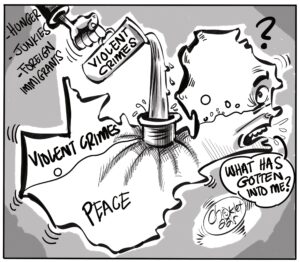ECONOMIST Caesar Cheelo says the Bank of Zambia’s (BoZ) increased lending to government is tantamount to the printing of more money that has been reflected in the increased amount of cash in circulation.
The central bank has remained silent on the official position as to whether or not it is printing money in response to the sudden surge in huge volumes of cash being splashed around by PF members, saying Law Enforcement Agencies (LEAs) must be engaged for action.
Recent BoZ data reveals that the central bank’s lending to government more than doubled to 7.0 per cent of GDP as at end of December, 2020, from 3.1 per cent of GDP as at end of December, 2019, which is consistent with trends in narrow money (M1) supply, which had skyrocketed by 46.6 per cent year-on-year as at end December, 2020, from just 4.8 per cent year-on-year at end December, 2019.
In response to a press query, Cheelo explained that the question of the central bank having printed more money was confirmed by the data, but added that the printing of money was also about increasing the circulation of the current given stock.
“So, the simple explanation is that ‘printing money’ is not really about bringing in hard currency into circulation from the mint, it is about increasing the circulation of the current given stock of money,” Cheelo, the outgoing Zambia Institute for Policy Analysis and Research (ZIPAR) senior research fellow, said.
He stated that with the fiscal deficit swelling to 14 per cent of GDP by the end of last year, it appeared that the BoZ financed 50 per cent of the deficit.
He added that the central bank was lending funds to government by printing money or pushing more money supply into circulation than the market demanded.
“So, for instance, M1 (narrowly defined money supply by BoZ) started to increase on a sustained basis around October, 2019, only one month after BoZ starting increasing its lending to government in September, 2019. Essentially, BoZ was lending to government by printing money or pushing more M1 into circulation than the market was actually demanding,” he revealed.
He further stated that with limited budget financing options, it was clear that government increased its dependence on the central bank to provide the much-needed financing.
“This is what printing money looks like. With limited budget financing options, government has increased its reliance on the BoZ to provide financing,” stated Cheelo.
The increased money supply in circulation coincides with a correspondingly high annual rate of inflation, now sitting at 22.2 per cent, a near-five-year high, as prices of essential goods and services continue to escalate months before a crucial general election.
And responding to a separate press query, BoZ assistant director – communications – Besnat Mwanza did not categorically confirm or deny incessant speculation that the central bank had printed more money to inject into the local economy, with the cash ending up in ruling party officials’ pockets.
Mwanza insisted that LEAs must be engaged for further action on the enforcement of anti-money laundering measures.
“The second point to stress with regards to currency held by individuals is that there are laws and regulations passed by Parliament and implemented by government, government agencies and public bodies, which deal with issues of criminality (including illicit financial transactions, tax evasion, or money laundering). The relevant government Ministries have already pronounced themselves on these matters and we would suggest that you follow-up with them on any actions that are or may be taken. You may wish to note, however, that BoZ has strict know your customer requirements that the commercial banks are required to follow and uphold,” stated Mwanza.
“The governor (Christopher Mvunga) at his November (2020) MPC press briefing addressed the issue of printing of money and highlighted the fact that the BoZ provides money to the economy with an eye to ensuring that this is sufficient to meet the underlying needs of the economy. As you are aware, money is used to pay for goods and services and to finance economic activity in general. It is also used as a store of value. The data on money supply, which includes currency in circulation, is readily available on our website www.boz.zm in the fortnightly statistics. You will note that the central bank generates money supply primarily through its interactions with commercial banks and in support of their requirements.”
























